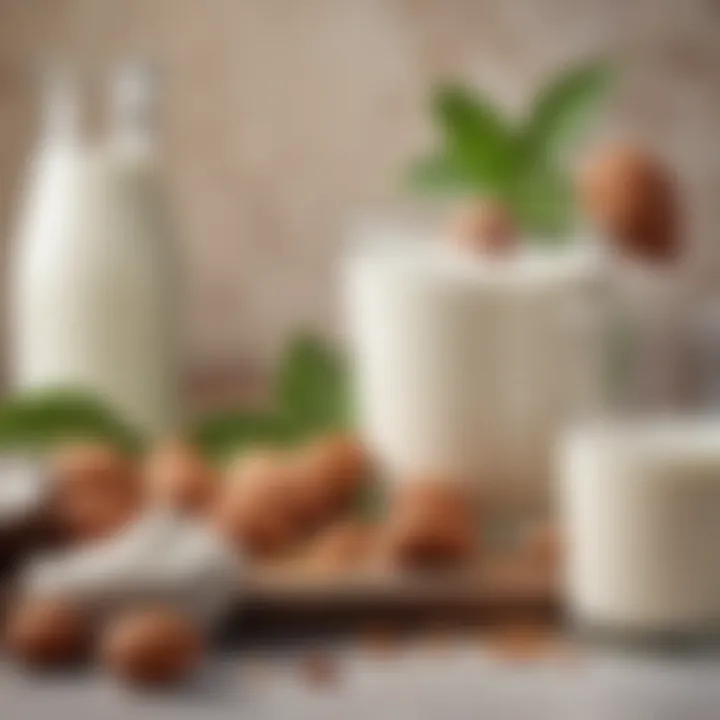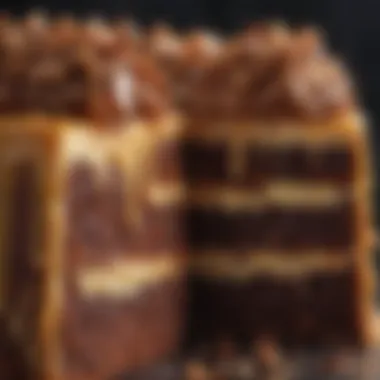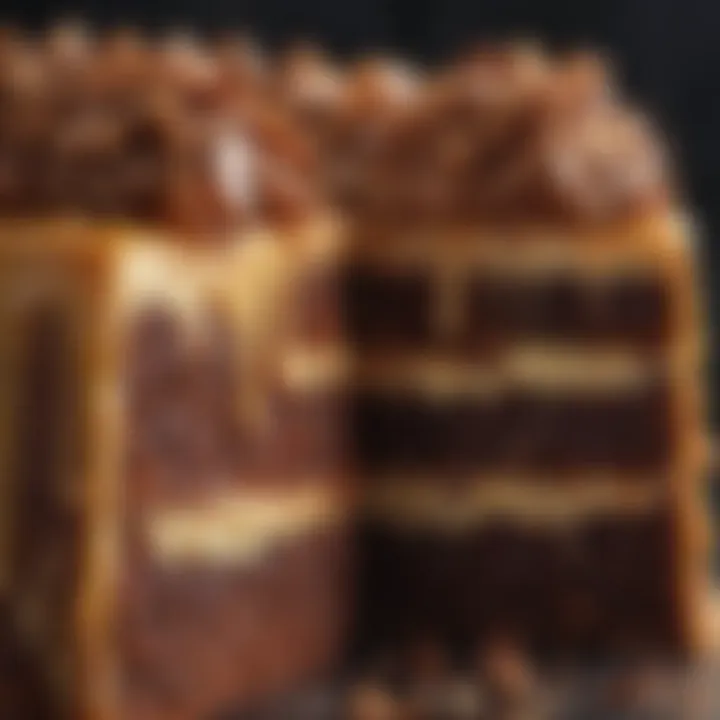Mastering Vegan Cake: A Complete Guide


Recipe Highlight
Vegan Chocolate Bliss Cake
This delightful vegan chocolate cake is a much-loved favorite among dessert enthusiasts. Its rich, moist texture and deep chocolate flavor make it perfect for any occasion.
Essential Ingredients
- 1 ½ cups all-purpose flour
- 1 cup cocoa powder
- 1 cup granulated sugar
- 1 tsp baking soda
- ½ tsp salt
- 1 cup unsweetened almond milk
- 1/3 cup vegetable oil
- 1 tbsp apple cider vinegar
- 1 tsp vanilla extract
Estimated Time
- Preparation: 15 minutes
- Cooking: 30 minutes
- Total: 45 minutes
Servings
This recipe yields about 8 servings.
Step-by-Step Instructions
- Preheat your oven to 350°F (175°C). Grease and flour an 8-inch round cake pan.
- In a large bowl, whisk together the flour, cocoa powder, sugar, baking soda, and salt until well combined.
- In a separate bowl, combine the almond milk, vegetable oil, apple cider vinegar, and vanilla extract. Mix well.
- Pour the wet ingredients into the dry ingredients. Stir gently until just combined, avoiding overmixing, which can lead to a dense cake.
- Transfer the batter to the prepared cake pan. Spread it evenly.
- Bake in the preheated oven for about 30 minutes or until a toothpick inserted in the center comes out clean.
- Allow the cake to cool in the pan for 10 minutes, then turn it out on a wire rack to cool completely.
Cooking Tip: Overmixing can cause the cake to become tough, so mix just until combined.
Variations and Substitutions
- Flour Alternatives: Use whole wheat or gluten-free flour for different textures.
- Sweetener Options: Substitute granulated sugar with coconut sugar or maple syrup for a healthier option.
- Flavor Additions: Add chocolate chips, walnuts, or even a hint of espresso powder for a richer taste.
- Frosting Ideas: Top with vegan chocolate ganache or coconut whipped cream for an indulgent finish.
Time-Saving Cooking Tips
- Prep Ingredients Ahead: Measure and mix dry ingredients in advance.
- Use a Food Processor: This can speed up chopping nuts or creating quick mixtures.
- Batch Baking: Bake two cakes at once and freeze one for quick desserts later.
Nutritional Information
- Calories: Approximately 200 calories per serving.
- Key Nutrients: Rich in fiber and low in cholesterol. Provides essential vitamins and minerals without animal products.
- Diet Suitability: Ideal for vegan and plant-based diets. Adjust with gluten-free alternatives as needed.
In summary, mastering the art of vegan baking, particularly with a recipe like the Vegan Chocolate Bliss Cake, not only satisfies the taste buds but also expands the options available to those observing dietary restrictions. The techniques and variations discussed can help any baker get more from their ingredients, paving the way for creative culinary experiments.
Prelude to Vegan Baking
Vegan cakes offer a myriad of benefits. They often utilize natural sweeteners, whole grains, and healthy fats, enhancing flavor profiles while promoting better health. Additionally, replacing eggs and dairy with plant-based alternatives allows for innovative combinations that lead to unexpected textures and tastes. This exploration into vegan baking invites bakers of all levels to experiment and expand their knowledge, ultimately enhancing their culinary skills.
However, it is essential to highlight key considerations. Understanding the properties of various plant-based ingredients is crucial. This knowledge empowers bakers to create moist, flavorful cakes without compromising texture or taste. In this guide, we will explore not only the art of making vegan cakes but also the underlying principles that contribute to their success.
The Rise of Veganism
Veganism has seen considerable growth in popularity over the past decade. This rise correlates not just with dietary choices but also with broader social movements. The shift towards plant-based eating is influenced by a variety of factors including health consciousness, environmental sustainability, and animal rights. Many now recognize the wholesome benefits of a plant-based diet, motivating them to lessen or eliminate animal products.
The notion of veganism goes beyond food; it encompasses a lifestyle that advocates for a more sustainable world. The demand for vegan products, including baked goods, has surged in response to this societal shift. Bakeries are increasingly responding with innovative options that satisfy the palate while aligning with ethical values. This promotes a culture of inclusivity where individuals with different dietary preferences can enjoy delightful creations together.
What Constitutes a Vegan Cake?
A vegan cake, by definition, is a cake that excludes all animal-derived ingredients. This means no eggs, dairy, or honey. Instead, vegan bakers rely on a variety of plant-based alternatives that serve similar functions in baking.
Key components of vegan cakes include:
- Flours: Various flours such as all-purpose, whole wheat, almond, or gluten-free blends.
- Sweeteners: Natural sweeteners like coconut sugar, maple syrup, or agave nectar instead of refined sugar.
- Binding Agents: Ingredients like flaxseed meal mixed with water, aquafaba, or plant-based yogurt in place of eggs.
- Fats: Oils such as coconut, avocado, or nut butters replace traditional butters.
- Leavening Agents: Baking soda and vinegar often act together to create rise without eggs.
When combined thoughtfully, these ingredients can yield a cake that is both satisfying and indulgent. The challenge lies in balancing flavors and textures while eliminating animal products. Understanding these components is vital for anyone looking to explore the world of vegan baking.
Essential Ingredients for Vegan Cakes
In vegan baking, the freedom to create delightful cakes comes largely from understanding the essential ingredients. Each component plays a crucial role in determining flavor, texture, and overall quality. Recognizing these ingredients helps to craft cakes that are not only enjoyable but also align with a plant-based lifestyle. The choice of ingredients can affect moisture, rise, and sweetness in a manner that embodies the very essence of what a cake should be.
Flour Varieties
Flour serves as the backbone of any cake. When it comes to vegan cakes, the type of flour selected influences the texture. All-purpose flour is often a go-to choice due to its versatility. However, experimenting with alternatives like whole wheat flour or almond flour can yield different results. Whole wheat flour adds a nutty flavor and denser texture, while almond flour can provide moisture and richness. A blend of flours can also be beneficial, using a mix of all-purpose and cake flour for a lighter bite. This variation can help appeal to diverse preferences while enhancing nutrient content.
Sugar and Sweeteners
In vegan baking, sugar types can range from regular granulated sugar to more natural options like coconut sugar and maple syrup. Each sweetener brings a distinct taste and texture to the cake. Granulated sugar helps achieve a light and fluffy crumb, while coconut sugar may offer a slight caramel flavor with a darker color. Moreover, liquid sweeteners such as agave nectar must be carefully balanced in recipes to maintain the proper liquid-to-dry ingredient ratio. Understanding these nuances allows bakers to create cakes that satisfy different palates while considering health aspects.


Binding Agents and Substitutes
When making vegan cakes, binding agents become essential. These components are vital since they mimic the role of eggs, helping to hold all ingredients together. Flaxseeds and chia seeds are popular choices when combined with water to create a gel-like substance. Other substitutes include applesauce or mashed bananas, which not only bind but also add moisture and flavor. Knowing how to effectively utilize these substitutes will ensure a cake remains structurally sound while delivering a palatable taste.
Fats in Vegan Baking
Fats contribute richness and help with moisture retention. For vegan cakes, options such as coconut oil or vegan butter are often preferred. Coconut oil can impart a light coconut flavor and gives solid structure when cooled. Vegan butter can closely replicate the buttery flavor found in traditional baking. When choosing fats, consider that liquid fats typically yield a richer, denser final product, while solid fats can create a fluffier texture. It’s essential to strike a balance to achieve the desired consistency in the final cake.
Flavor Enhancers
The final touch to a vegan cake involves flavor enhancers such as extracts, spices, and zests. Vanilla extract is perhaps the most common, adding depth to sweet baked goods. However, diversifying flavors with almond extract, citrus zests, or spices like cinnamon and nutmeg can elevate a cake significantly. These enhancements can differentiate a basic recipe into something unique and memorable. Balancing these flavors carefully offers potential for creativity that resonates with various taste preferences.
Understanding these essential ingredients allows bakers not only to replicate traditional cake qualities but also to innovate and explore new possibilities within vegan baking.
Tools and Equipment Required
When venturing into vegan baking, the right tools and equipment are crucial. They can greatly impact the outcome of your cake. Having the necessary tools creates an environment where precision and creativity can flourish. This section outlines the essential bakeware, mixing and measuring tools, and specific oven considerations, each serving a unique purpose in the cake-making process.
Essential Bakeware
The choice of bakeware affects the texture and cooking time of vegan cakes. Non-stick pans work well for easy removal of the cake after baking, reducing the chance of breaking or sticking. Glass or ceramic casseroles can be used, but they often need adjustments in baking times, given their heat retention qualities. Additionally, silicone bakeware offers flexibility. It's easy to work with and ensures even cooking. Here are a few key points to keep in mind:
- Types of Pans: Round, square, or rectangular pans allow for various cake designs.
- Size Matters: Consider the size of your recipe. Ensure your baking pan can accommodate the batter to prevent overflow.
- Maintenance: Non-stick pans require proper care to maintain their coating for long-term use.
Mixing and Measuring Tools
Accurate mixing and measuring tools are vital for crafting a successful vegan cake. Precise measurements can drastically affect the texture and flavor of the finished product. Here, the focus is on:
- Measuring Cups and Spoons: Utilizing both dry and liquid measuring cups ensures exactness. Standard measuring cups generally come in sets and should be used for dry ingredients, while liquid measuring cups with spouts are best for wet ingredients.
- Mixing Bowls: Lightweight glass or stainless steel bowls work well. They are durable and can be easily cleaned after use.
- Whisks and Spatulas: A good whisk is essential for blending wet ingredients. Silicone spatulas are excellent for scraping down the sides of bowls and ensuring no batter is wasted. Moreover, a hand mixer or stand mixer can save time and energy, especially for mixing dense batters.
Oven Considerations
Oven variances can be a significant factor in vegan baking. Each oven has its personality, impacting baking times and temperatures. To achieve the best results, keep these considerations in mind:
- Temperature Calibration: Always calibrate your oven. Investing in an oven thermometer helps maintain the right temperature, leading to even baking.
- Preheating: Always preheat before placing your cake in the oven. A well-heated oven is key to rising properly.
- Placement in Oven: Position the rack in the center for even heat distribution. Avoid opening the oven door frequently to prevent temperature fluctuations.
Proper tools and equipment will not only make the baking process smoother but can also enhance the overall flavor and appearance of your vegan cake.
The Baking Process
Understanding the baking process is crucial for successfully creating a vegan cake from scratch. It encompasses not only the method of combining ingredients but also the nuances of achieving the desired texture and flavor. Each step in the baking process plays a significant role in the final product.
Preparing the Ingredients
Before any mixing begins, preparing the ingredients ensures a smoother workflow and improves the final outcome. It's important to measure each ingredient accurately. For instance, using a kitchen scale for dry ingredients helps prevent discrepancies that can impact texture. Additionally, all ingredients should be at room temperature unless specified otherwise. This includes plant-based milks, oils, and even aquafaba, as it aids in better emulsification during mixing. Keep the preparation area tidy and organized. Group similar ingredients together to avoid confusion later.
Mixing Techniques
Mixing is where the magic happens. Each mixing technique can influence the cake's density and texture. Blend the dry ingredients first; this helps distribute leavening agents evenly. When combining wet and dry ingredients, it is advisable to stir gently. Over-mixing can lead to a dense cake since it develops gluten. In vegan baking, fold in ingredients like aquafaba or whipped coconut cream lightly. This maintains airiness, which is essential for creating a light and fluffy cake. Different recipes may suggest variations in mixing, so adapting your approach based on the specific requirements is beneficial.
Baking Times and Temperatures
The right baking time and temperature are fundamental to achieving the perfect cake. Generally, vegan cakes are baked at temperatures ranging from 160 to 180 degrees Celsius (320 to 350 degrees Fahrenheit). The size of the cake pans also affects baking time. Smaller cakes bake faster than larger ones. Always refer to the recipe for guidance, but using a timer can help you avoid overcooking. It's advisable to preheat the oven to ensure consistent heat distribution.
Testing for Doneness
Testing for doneness can be done simply yet effectively. One common method is the toothpick test. Insert a toothpick in the center of the cake; if it comes out clean or with just a few crumbs, the cake is ready. Another method involves gently pressing the top of the cake. If it springs back, it's a good sign that it's done. Monitoring closely in the last few minutes can prevent an overbaked cake, which can turn dry.
Key Point: The nuances of the baking process are essential for mastering the art of vegan cake creation. Each step requires attention, ensuring that the cake is not just delicious but also has the right texture and appearance.
Common Variations of Vegan Cakes
In crafting vegan cakes, exploring common variations can significantly enhance both flavor and presentation. This section highlights how different styles appeal to a wide range of palates and occasions. Adding variety broadens the audience for vegan cakes, showing that they can be just as delightful and diverse as traditional cakes. Consider the following popular forms:
Chocolate Vegan Cakes
Chocolate vegan cakes are often a favorite among both vegans and non-vegans. The richness of cocoa can mask the absence of dairy and eggs, creating a moist, decadent cake. Using ingredients like cocoa powder, almond milk, and apple cider vinegar, one can achieve an indulgent dessert that satisfies chocolate cravings. Further, options like dark chocolate or vegan chocolate chips can enhance both texture and taste.
When preparing a chocolate vegan cake, it’s essential to pay attention to the balance of wet and dry ingredients. Overmixing can lead to a dense texture, while a lack of moisture can result in a dry outcome. Many recipes also suggest incorporating espresso powder to deepen the chocolate flavor.


Fruit-Based Vegan Cakes
Fruit-based vegan cakes offer a refreshing twist to conventional baking. These cakes frequently use fruits like bananas, apples, or berries as primary ingredients. Bananas can serve as a fantastic binding agent, while applesauce often acts as a sugar substitute, making the cake lighter and healthier. The natural sweetness of fruits allows for less added sugar, making them suitable for various dietary preferences.
Additionally, incorporating seasonal fruits can enhance the flavor profile. For instance, using ripe strawberries in spring or pumpkin puree in autumn inform the cake’s overall taste. A fruit-based cake often feels more vibrant and elementally simple.
Nuts and Seeds Variations
Nuts and seeds are another excellent component of vegan cakes. The crunch of walnuts or the smoothness of almond meal adds both texture and nutritional benefits. Ground flaxseeds or chia seeds can serve as effective egg substitutes, providing structure and moisture. When incorporating these elements, they not only enhance the flavor but also boost the protein content of the cake.
These variations can cater to nut lovers and those seeking to add dietary fiber and healthy fats into their desserts. However, one must be mindful of allergies, as some guests may have nut sensitivities.
Spiced Vegan Cakes
Exploring spiced vegan cakes brings about a new dimension of flavor. Spices like cinnamon, nutmeg, and clove can transform a simple recipe into something aromatic and inviting. Pumpkin spice cakes or gingerbread versions are perfect examples that integrate these elements seamlessly. Seasonal flavors often evoke nostalgic feelings, making them perfect for holidays or special events.
When using spices, the key is to understand their strength and how they complement the main ingredients. A well-balanced cake can leave a lasting taste without overpowering the other flavors.
"Baking vegan cakes is as much an art form as it is a science; the variations available allow for endless creativity and personalization."
Decorating Your Vegan Cake
Decorating a vegan cake is not just an aesthetic endeavor; it is integral to creating a dessert that is pleasing to both the eye and palate. The appearance of a cake often enhances the overall eating experience. With vegan baking, this becomes an opportunity to showcase creativity while adhering to plant-based practices. The choice of decorations also impacts flavor, texture, and presentation, making it crucial to consider how these elements come together effectively.
Here are a few reasons why decorating your vegan cake is significant:
- Enhances Visual Appeal: A well-decorated cake draws attention and conveys the effort involved in its preparation.
- Adds Flavor Dimensions: Toppings and frostings contribute diverse flavors that complement the cake’s base.
- Sets Mood for Occasion: Unique designs can cater to specific celebrations or seasonal themes, making them perfect for any event.
Ultimately, decorating transforms a simple cake into a centerpiece, capturing the essence of the occasion.
Frosting Options
When it comes to frosting, there are numerous vegan-friendly options available. Each type of frosting caters to different flavor preferences and dietary needs, which provides flexibility to bakers. Understanding some foundational frostings can help enhance any cake.
- Vegan Buttercream: Made from vegan margarine or shortening, powdered sugar, and plant-based milk. It’s thick, creamy, and easy to flavor with vanilla, cocoa, or citrus.
- Aquafaba Frosting: This unique frosting uses the liquid from canned chickpeas, whipped into stiff peaks similar to egg whites. The result is light and airy, ideal for a delicate touch.
- Chocolate Ganache: Mixing dairy-free chocolate with coconut cream yields a rich and glossy topping, perfect for deep flavor profiles.
- Fruit-Based Frosting: Pureeing fresh fruits like strawberries or blueberries can create a vibrant and naturally sweet frosting. Just add a thickener for consistency.
Each option provides a unique characteristic that can elevate your cake, offering both taste and presentation.
Garnishing Techniques
Garnishing a vegan cake goes beyond mere decoration. It introduces additional textures and flavors, providing an opportunity to get creative. Here are several techniques to consider:
- Fresh Fruits: Adding slices of seasonal fruits like strawberries, kiwi, or citrus not only enhances visual appeal but also offers freshness to each bite.
- Nuts and Seeds: Chopped nuts like almonds, walnuts, or sunflower seeds add crunch. They can be sprinkled on top or used as a border around the base.
- Edible Flowers: Consider fresh edible flowers such as pansies or violets. They lend an elegant touch and are entirely plant-based, ensuring they fit within vegan guidelines.
- Cocoa or Powdered Sugar Sprinkling: A light dusting can create an effortless yet refined finish. Use a stencil for shapes or patterns to add creativity.
Incorporating these garnishes allows one to tailor the cake to suit the theme or personal preferences, ultimately enriching both the presentation and taste.
Storing and Preserving Vegan Cakes
Storing and preserving vegan cakes is a crucial aspect of vegan baking. Once you have crafted the perfect cake from scratch, it becomes essential to maintain its texture, flavor, and moisture over time. Improper storage can lead to drying out or spoilage, making even the best recipes disappointingly inedible. Understanding how to effectively store and preserve your vegan creations ensures that they remain enjoyable long after the initial baking. This section will explore best practices for storage, as well as methods for freezing and reheating.
Best Practices for Storage
Choosing the right storage method can significantly enhance the shelf life of vegan cakes. Consider these best practices for optimal results:
- Cool Completely: Always allow your cake to cool completely before storing. This prevents condensation from forming, which can lead to sogginess.
- Use Airtight Containers: Once cooled, store the cake in an airtight container. This helps to keep the cake fresh by preventing air exposure.
- Separate Layers with Parchment Paper: If the cake has multiple layers, place parchment paper between each layer before sealing. This prevents the layers from sticking together.
- Keep in a Cool, Dry Place: Store the cake in a cool, dry location such as a pantry. Avoid placing the cake in direct sunlight or humid areas, as these conditions can spoil it faster.
Following these storage tips not only extends the shelf life but also preserves the delightful taste and texture of your vegan cake.
Freezing and Reheating
Freezing your vegan cake can be an excellent way to extend its shelf life even further. Here are steps and tips for effective freezing and reheating:
- Wrap It Well: To freeze a vegan cake, wrap it tightly in plastic wrap. Ensure all parts are covered without any air gaps. For added protection, wrap it in aluminum foil as well.
- Label and Date: It is advisable to label the package with the date and type of cake. This helps to keep track of how long the cake has been stored.
- Storage Duration: A vegan cake can typically be frozen for up to three months without losing much flavor or texture. Beyond that, it may begin to deteriorate.
When you are ready to enjoy the cake again:
- Thawing: To thaw the cake, place it in the refrigerator for several hours or overnight. This gradual thawing helps maintain the cake's moisture.
- Reheating: If you prefer a warm slice, you can reheat it in an oven at a low temperature for a few minutes. Alternatively, you can use a microwave for short bursts, keeping in mind that overdoing it may dry out the cake.
Using the proper storage and preservation methods will ensure that your vegan cake remains delicious and enjoyable, allowing your hard work to be appreciated over time.


By understanding storage techniques, you can avoid wastage and keep your vegan cakes ready for any occasion. attention to these details can significantly elevate your baking experience.
Experimenting with Vegan Cake Recipes
Experimenting with vegan cake recipes is a vital part of the vegan baking process. It allows bakers to discover new flavors and textures while accommodating different dietary preferences. This section highlights the significance of creative experimentation and its numerous benefits.
When one experiments with vegan cake recipes, the possibilities are endless. Each ingredient brings its own unique attributes to the mix. For instance, different types of flours can greatly affect the cake's crumb and structure. Using chickpea flour instead of all-purpose flour introduces protein and a slightly nutty flavor. Such innovations can elevate a basic recipe into something extraordinary.
Baking vegan cakes should no longer be confined to traditional recipes. Instead, it encourages individuals to engage with the process. By substituting ingredients and adjusting ratios, bakers can personalize their cakes to suit their tastes and dietary restrictions. The ability to customize recipes means everyone can create a cake that aligns with their palate. Moreover, it can cater to those with allergies, such as gluten sensitivity or nut intolerances. This tailoring aspect is particularly important in today's diverse dietary landscape.
There are some considerations to keep in mind during experimentation. For example, it is essential to note how certain plant-based alternatives behave under heat. Aquafaba, the liquid from canned chickpeas, can replace egg whites for improved texture. However, it is necessary to measure it accurately to avoid unintended results. Balancing the various ingredients is crucial to maintain cake integrity.
The fundamental principle of baking is chemistry. Hence, adjustments to ingredients might lead to unexpected outcomes. This uncertainty is part of the joy of baking. If a cake does not turn out as expected, there is always room for learning and improvement. Embracing this mindset can transform mistakes into valuable lessons for future baking endeavors.
"Baking is both an art and a science. The key is to enjoy the process and learn from every attempt."
In summary, experimenting with vegan cake recipes not only enhances creativity but also promotes inclusiveness. It's a journey that involves discovery, adaptation, and personal expression.
Customizing Flavors
Customizing flavors in vegan cake recipes is an essential aspect of creating a cake that resonates with personal taste. There are numerous ways to achieve this. One commonly used method is extracting flavors from various natural ingredients. Vanilla extract, almond extract, and lemon zest are just a few examples that can enhance the overall experience. These natural enhancers can bring a subtle or bold nuance to cakes.
Aside from extracts, fresh fruits can be an excellent way to introduce new flavors. Incorporating mashed bananas, pureed pumpkin, or even adding chunks of berries can dramatically change the taste profile. These additions not only provide flavor but also maintain moisture, which is important in vegan baking.
Spices can also play a crucial role in customization. Incorporating spices such as cinnamon, nutmeg, or cardamom can elevate the cake from ordinary to extraordinary. A spiced vegan cake can evoke warmth and richness that is appealing to many. The key is to strike a balance between the flavors to ensure that no single ingredient overpowers another.
Incorporating Seasonal Ingredients
Incorporating seasonal ingredients into vegan cake recipes is a strategic way to enhance flavor and freshness. Seasonal ingredients are often at their peak in terms of taste and nutritional value. For example, using fresh strawberries in June or pumpkin in autumn can make a cake not just enjoyable but also relevant to the time of year.
When choosing seasonal fruits and vegetables, it is helpful to visit local markets. Those markets often have a variety of ingredients that are harvested at the right time. This can inspire bakers to try new combinations that they may not have considered before.
The changing of seasons also provides the chance to experiment with spices that resonate with the time. For example, embracing winter flavors like ginger or cloves can create a festive cake that is perfect for holiday celebrations.
Health Considerations and Nutritional Aspects
Health considerations play a crucial role in vegan baking. Understanding the nutritional aspects of vegan cakes not only helps in crafting delicious desserts but also ensures that the cakes align with dietary goals. This segment focuses on the benefits that come with using plant-based ingredients and addresses important factors such as allergies and dietary restrictions. Having this knowledge empowers bakers to create cakes that are both healthy and suitable for a wider audience.
Nutritional Benefits of Vegan Ingredients
Using vegan ingredients can offer several nutritional benefits. These benefits stem from the plant-based nature of the ingredients chosen. For example, many fruits, vegetables, nuts, and grains are rich in vitamins and minerals.
- Fruits such as bananas and apples can replace eggs and add moisture. They are high in fiber and contain essential vitamins like vitamin C.
- Nuts and seeds provide healthy fats and protein. They also enhance the flavor and texture of the cake. Ground flaxseed, for instance, serves as an excellent egg replacement while being rich in omega-3 fatty acids.
- Whole grains like whole wheat or oat flour increase fiber content, aiding in digestion and prolonging satiety.
- Natural sweeteners like maple syrup or agave nectar have lower glycemic indexes compared to refined sugars. This can be beneficial for those monitoring blood sugar levels.
Choosing these ingredients not only aligns with vegan principles but also can contribute to improved overall health.
Allergies and Dietary Restrictions
Vegan cakes are often suitable for individuals with certain allergies or dietary restrictions. However, it is crucial to consider which ingredients can trigger reactions. Common allergens include wheat, nuts, and soy. It is possible to make adjustments to recipes to accommodate specific needs:
- Gluten-free options can be created by using almond or coconut flour. This makes the cake accessible for those with gluten intolerance or celiac disease.
- Nut-free varieties can be crafted by using seed butters such as sunflower seed butter. This is ideal for those allergic to nuts.
- Dairy alternatives can replace dairy in traditional recipes. Options include coconut milk or almond milk, which also add texture without compromising flavor.
To ensure safety, always label cakes properly if used in settings where allergies are a concern.
Vegan baking offers a versatile framework that can accommodate a variety of health needs. Customized cakes can meet both taste and dietary requirements.
In summary, health considerations are pertinent when crafting vegan cakes. The use of nutritious ingredients enhances the quality of the final product. By being aware of potential allergens and dietary restrictions, bakers can successfully navigate the complexities of vegan baking while providing flavorful options.
Finale
The conclusion of this article encapsulates the essence of crafting a vegan cake from scratch. It emphasizes the harmonious blend of creativity and health consciousness that defines vegan baking. Understanding the core elements discussed enhances one's ability to bake delicious and satisfying vegan cakes. Different ingredients and techniques come into play, encouraging both novices and experienced bakers to explore new avenues in the kitchen.
In summary, vegan baking is not just a substitute for traditional methods; it represents a thoughtful approach to creating desserts that align with plant-based diets. The transition to vegan baking unlocks a world of flavors and textures that can delight the palate.
Recap of Key Takeaways
- Ingredient Knowledge: Familiarity with vegan substitutes is crucial. Knowing what ingredients to use ensures that the cake maintains its intended flavor and texture.
- Baking Techniques: Understanding mixing methods and baking temperatures is essential for achieving that perfect rise and moistness.
- Creative Freedom: Exploring various flavor combinations allows personalization of each cake. One can adjust recipes based on preferences, showcasing individual baking styles.
- Nutritional Awareness: Recognizing the health benefits of plant-based ingredients helps in making informed choices. This perspective enhances both the baking experience and the final product.
"Vegan baking is more than a trend; it’s a journey towards healthier eating and culinary creativity."
Encouragement for Exploration
As this article has outlined, the journey of vegan cake baking is filled with endless possibilities. The process invites experimentation with flavors and techniques. It encourages bakers to try different plant-based options, from aquafaba to chia seeds. Embracing this exploratory spirit can lead to exciting discoveries about what constitutes great cake.
Moreover, connecting with the vegan baking community offers support and inspiration. Engaging in discussions on platforms like Reddit or joining groups on Facebook can provide valuable insights and creative ideas. These communities often share tips, recipes, and experiences, enriching one's baking repertoire.







